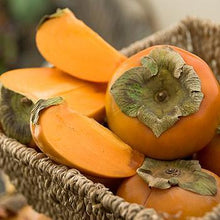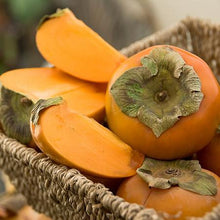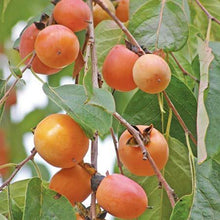Sweet and Nutty Flavor!
Also known as the "common persimmon," this bright-orange -- and sometimes yellow, red and even blue -- fruit bearing tree is anything but common.
In fact, it's uncommonly available at most nurseries and greenhouses, and has uncommonly delicious ripe product -- the shape of a one- to two-inch beefsteak tomato -- that lends itself to cakes, cookies, sorbets, and ice cream.
Its high calcium, vitamin C, potassium and iron yield also makes it a high-energy dried snack and its pulp freezes well for future use.
As an addition to your landscape, this Kentucky native, while a slow grower and slow to mature to "fruit-ion", can be pruned initially to have either a strong central leader (trunk) or open center.
American Persimmon branches, typically starting just two or three feet from the ground, need little pruning once they become fruit-bearing to maintain their broad-spreading, wide-base shape.
Foliage color variety enhances any garden or open space, and this long-oval leafed tree transforms through the seasons from light bright green, through dark pine to fall colors in the same warm range as its fruit: yellow, orange and salmon, tinged with red and crimson. In the spring, it is festooned with yellow-white, waxy, open-bell shaped flowers that begat acid green unripe fruits.
The American Persimmon also brings abundant fruit-eating wildlife to your yard. If you are a rural grower, you can expect copious deer as they are drawn to the fruit like kids to candy. Families that hunt will find the woods nearby well populated with game as a result; the fruit hangs on the trees well through the hunting season. Whether you live in the country or city, your American Persimmon will also attract a wide variety of regional songbirds as well as squirrels, raccoons and even bats.
The Edible Economics of Persimmon Fruit
While fiercely bitter and sour unripe, the ripe persimmon is richly sweet and almost nutty in flavor. Your persimmon(s) will begin to bear fruit as early as three years, and as late as 10 from initial young-tree planting. Each tree can yield from 35 to 75 pounds of hand-picked fruit, harvested after a long season of ripening before or long after the first frosts. With the right market established, growers expect to sell their crop for about $2.75 per pound. Commercial crops typically consist of 300 $20 trees per acre with profitable yields at year four. The wood of the persimmon also has a market for crafting of musical instruments.
Preferred Culture and Cultural Practices
Healthiest and happiest in USDA Hardiness Zones 7-9, your persimmon may also do well in Zone 6, so long as you grow it in well-draining but moist loam soil, and water frequently; while mature trees can handle some drought, young trees cannot. While very cold and freeze hardy, it is good to protect your trees from early frosts in a low-lying area, thus increasing ripening time. Other than these considerations, you'll find your American Persimmon to be adaptable to everything from flood plains to wooded areas, and full sun to partial shade.
Planting & Care
The American Persimmon tree (or Diospyros virginiana 'American') is a more cold tolerant tree growing in zones 4 through 9, a bit more hardy over its hotter climate cousin, the fuyu persimmon. The American (sometimes referred to as the “common persimmon”) is native to Kentucky and produces a smaller, richer tasting fruit. Native Americans were known to use the fruit of the american persimmon for a winter food source and the wood for crafting as it is strong and very resistant. They are not known to be really fast growers, but they are quite resilient. The American Persimmon can get to be as tall as 50 feet at maturity and roughly 25-30 feet wide! They have a delightful fall foliage color that can be yellow or pink making them quite attractive for the colder season.
Choosing a location: Persimmons are quite adaptable to many different soil conditions but for the ideal growing conditions try and find a spot that will receive more full sun exposure with well draining soil. Try to avoid areas where water has a tendency to pool. They aren’t too picky regarding their soil but do perform best in a pH range of 6.5 to 7.5.
Planting Directions (in ground):
1) After you have found an ideal location, make your hole twice as wide as the root ball and just as deep. Be sure you’re at least 12 feet from any structures.
2) Arrange your tree in the hole at the same depth as it was in the shipping container/pot and begin to pack the soil around the roots until the soil is a little higher than level. The soil will settle after you’ve planted.
*TIP* You can amend some loam into the native soil for back filling for better results.
3) Water the planting site generously so the soil can fully settle and then spread a 2 inch layer of mulch around to preserve moisture as well as combat competing weeds that may try to grow nearby.
4) You may want to utilize stakes for proper support as the tree is acclimating and getting settled.
Planting directions (potted):
1) Water the tree’s root ball thoroughly before transplanting. This should help reduce the risk of shock.
2) Select a container that is three times the size of the root ball so it can be left undisturbed, will not require immediate re-potting and with plenty of space for several years of growth.
3) Line the bottom of the pot with a couple inches of gravel to ensure there will always be proper drainage and then cover with a good layer of potting soil.
4) Comb your hands along the edge of the root ball to gently free up the roots.
5) Center the tree into the pot, spread the roots out a bit and then fill in the remaining room with your potting mix. Tamp firmly but take care not to compact the soil or the root growth and water flow will be restricted.
6) Water generously and place the tree in a nice full sun spot where it will remain undisturbed for the growing season. Potted persimmons will need at least 8 hours of full sun exposure.
Watering: Newly planted trees will require deep watering. Persimmon trees have a taproot that can be difficult to water properly. The best thing to do is leave your garden hose on a slow trickle, and place it next to the base of the tree. Leave it there for a good thirty minutes so the water has a chance to properly penetrate the soil and get down to the taproot. Be sure to do this at least once a month and possibly twice in the hotter seasons. Persimmons are known for their drought tolerance, but young trees need to be watered well in their youth to help the slow developing taproot. Once they have developed for a few years, your natural rainfall should be sufficient in providing the tree water.
Like the potted fuyu persimmon, you will need to closely monitor the tree to get an idea for just how often you will need to water. You may need to water nearly every day in the warmer season. Lifting its container can be useful. If it’s heavy then chances are that the soil still has a fair amount of moisture to it. If it’s light, give it a drink.
Pruning: Hold off on pruning your American Persimmon tree for the first couple of years. In the winter season prune the tree into a modified central leader system. Six to eight spaced scaffold branches around the trunk should help support the future fruit. Always keep an open eye for suckers that may form at the base, and be sure to remove them as soon as they’re noticed. These guys can steal nutrients from the primary trunk (or leader) and stunt the growth. Once the trees have matured a bit, they will rarely ever require pruning except for removal of damaged or dead branches.
Fertilizing: As long as your American Persimmon has new growth measuring at least a foot, then there should be no need to fertilize the tree. If you do find the need to fertilize, try to avoid overdoing it on nitrogen. If the build up has gone too far then it will cause early fruit drop. The recommended approach is to fertilize in the late winter using about 5 to 10 pounds of compost to keep the tree growing well.
Harvesting: Persimmons are typically ready for harvesting around September to December. The Asian breeds tend to cling tightly to the branches so you may need to use clippers to remove them. The American Persimmon is a breed that will typically just drop the fruit when it has become fully ripened. If you are having a lot of animals eating your persimmons just before they have a chance to fully ripen there is a great trick to utilize. Put the fruit in a plastic bag with a few bananas for about a week to ten days and place them in a warm room. Bananas throw off a gas called ethylene and will assist in the ripening of the persimmons.





